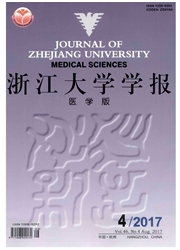

 中文摘要:
中文摘要:
背景与目的:研究三丁基锡(tributyhin,TBT)对人羊膜细胞FL(humanamnioncells)氧化损伤和DNA损伤的诱导作用。材料与方法:将不同浓度TBT(0、2、4、6、8、10μmol/L),分别对FL染毒2h和4h,各染毒组同时设不加TBT的对照组,染毒后分别用NIT法检测TBT对FL细胞增殖率的影响,用DCFH-DA法检测FL细胞活性氧自由基(ROS)水平,用彗星实验检测TBT对FL细胞DNA的损伤。结果:TBT对FL细胞染毒4h时,其2、8、10μmol/L浓度组的细胞增殖率较对照组显著下降(P〈0.05,P〈0,01,P〈0.001),且随TBT浓度升高而增殖率呈下降的趋势。TBT3.4μmol/L染毒组FL细胞的ROS水平较对照组升高,且4μmol/L染毒组与对照组比较差异具有统计学意义(P〈0.05)。在TBT2、3、4μmol/L染毒组随着TBT浓度的升高,FL细胞核尾长、尾相均显著升高(P均〈0.05)。结论:TBT可引起FL细胞的氧化损伤及DNA损伤。
 英文摘要:
英文摘要:
BACKGROUND AND AIM: The study was undertaken to assess the oxidative stress and DNA damage in human amnion cells induced by TBT. MATERIALS AND METHODS: Cultured FL cells were exposed to different concentrations of TBT (0, 2, 4, 6, 8, 10 μmol/L) for different durations (2 h and 4 h). Cell proliferation rate was evaluated by MTr assay. After exposure to different concentrations of TBT (0,1,2,3,4μmol/L) for 2 h,the ROS level and DNA damage of FL cells were measured by DCFH-DA method and the single cell gel electrophoresis method, respectively. RESULTS: After exposure to different concentrations of TBT for 4 h, the FL cell proliferation rates in the 2, 8, 10μmol/ L groups were significantly decreased as compared to control(P〈0.05, P〈0.01, P〈0.001) in a dose-dependent manner. The ROS level was increased in the 3 and 4 μmol/L groups in the dose-dependent manner and the difference was significant at 4μmol/L group compared to the control(P 〈0.05). Meanwhile, TBT exposure led to the interrelated increase of nucleus tail length and tail moment in a dose- dependent manner and the differences were significant at 2, 3 and 4μmol/L group compared to the control(P 〈0.05) . CONCLUSION: TBT exposure could cause oxidative stress and DNA damage to FL cells.
 同期刊论文项目
同期刊论文项目
 同项目期刊论文
同项目期刊论文
 期刊信息
期刊信息
